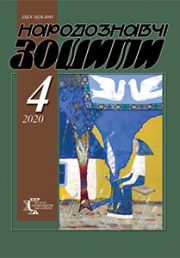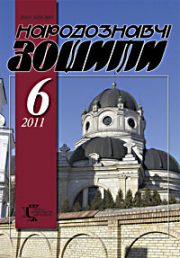The Ethnology Notebooks. 2018, 1 (139), 215–230
UDK 75/76.03-051(477)”191/199”П.Грегорійчук:7.046
DOI https://doi.org/10.15407/nz2018.01.215
Received 15.12.2017
ETHNOCULTURAL KNOWN ARTISTIC PROCESSES PETRO GREGORIJCHUK (1914—1990)
ORCID ID: https://orcid.org/0000-0003-1509-5367
Yatsiv Roman Myronovych, Vice-rector on the scientific work of the Lviv National Academy of Arts, Ph.D., associate professor, Honored Worker of Culture of Ukraine. Kubiiovycha Street 38, 79011, Lviv, Ukraine. Contacts: e-mail: jaciv@ukr.net
Abstract. The article deals with the life and creative path of the famous Ukrainian painter and the graphic Petro Gregoriichuk (1914—1990). Special attention is paid to the ethno-cultural sources of the inspiration of his paintings of different genres, from the period of formation of his outlook in his native Pokuttia, through the professional schools of Krakow and Warsaw, to the large-scale thematic cycles of the 1960—1980’s, implemented in Lviv. Proceeding from the numerous ideological, aesthetic and psychological obstacles faced by the artist in the period of Soviet totalitarianism, an attempt is made to interpret the scientific interpretation of his great creative heritage. The figure of the artist is compared with other personalities of the history of Ukrainian fine arts of the middle-end of the XX century, in particular the representatives of the Ukrainian artistic circle «Spokii» in Warsaw and the artistic association «Zarevo» in Krakow (1920—1930’s).
Keywords: Petro Gregoriichuk, fine arts, painting, graphics, modernism, ethnic culture, circle «Spokii», formalism, totalitarianism, artistic worldview, ideological and semantic field, structure of artistic image, moral and value context.
REFERENCES
Dilo. L’viv, 1939. Ch. 2. 3 sichnia.
Drahan, M. (1943). P’iata vystavka Spilky Ukrains’kykh Obrazotvorchykh Mysttsiv. Nashi dni. L’viv. Ch. 12. Hruden’.
Z istorii L’vivs’koi Spilky khudozhnykiv. Mystets’ki studii. L’viv, 1993. Ch. 2–3.
Kataloh mystets’koi vystavky. 1943. L’viv: Ukrains’kyj Tsentral’nyj Komitet; Spilka Pratsi Ukrains’kykh Obrazotvorchykh Mysttsiv, 1943.
Oblasna mystets’ka vystavka zhyvopysu, skul’ptury, hrafiky: Z nahody XXX richnytsi Velykoi zhovtnevoi sotsialistychnoi revoliutsii (Kataloh). L’viv, 1947.
Stebel’s’kyj, B. (1991). Krakivs’ka Akademiia Mystetstv i ukraintsi. Stebel’s’kyj B. Idei i tvorchist’: Zbirnyk statej ta eseiv. Toronto: Kanads’ke Naukove Tovarystvo im. Shevchenka.
Szacho-Gіuchowicz, A. (2012). Pracownia malarstwa Tadeusza Pruszkowskiego. Sztuka wszędzie. Akademia Sztuk Pięknych w Warszawie. 1904–1944. Warszawa: Akademia Sztuk Pięknych w Warszawie.
Sitkowska, M. (Ed.). (2012). Sztuka wszędzie. Akademia Sztuk Piкknych w Warszawie. 1904–1944. Warszawa: Akademia Sztuk Piкknych w Warszawie.







